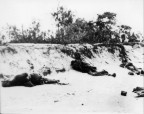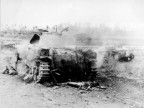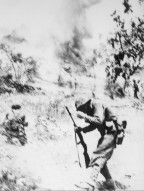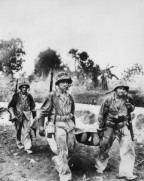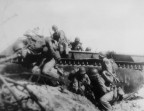When it
got daylight the next morning, every ship except the Hospital ship
was gone. We were told that the entire Japanese Fleet was heading
for Saipan, and our Navy went out to meet them. This was later known
as the "Great Marianas Turkey Shoot." Navy and Marine Corps
pilots destroyed most of their Carriers and Battleships and actually
broke the back of their Naval Forces. It's been said that Japan felt
that if it lost Saipan, the war was lost for them. IT WAS.
Editor's note:
The ships were, indeed, gone. Although not apparent to the troops
ashore, Admiral Raymond A. Spruance's prime objective was the protection
of the Saipan invasion forces, in particular the valuable troop and
supply transports. The largest carrier battle in history was
taking place. Beginning on June 11, 1944, 15 fast carriers and 12
escort carriers of the U.S. 5th fleet destroyed 1223 Japanese aircraft
and sank 110,000 tons of shipping.
He moved offshore
for maneuvering room because he knew that enemy carriers might appear,
but he would not be lured away from protecting the Saipan invasion
beaches. He would not endanger his prime responsibility by chasing
after the enemy.
The Japanese forces
commanded by Admiral Ozawa attacked the American carriers in wave
after wave. Fighter aircraft from Hornet and other carriers stopped
all the attacks before the Japanese reached the task force. Nearly
every Japanese aircraft was shot down in what became known as "The
Marianas Turkey Shoot." Only 35 operational aircraft remained
out of Ozawa's 430 planes (plus hundreds of land-based planes commanded
by Admiral Kakuta). U.S. air strikes also sank the Japanese carrier
Hiji and so damaged two tankers that they were abandoned and scuttled.
Cpl. Hoover was right! By the time the battle ended. Japan sustained
an irreversible defeat. While losing only 22 fighters and 60 men,
Spruance had removed Japanese carriers as a factor in the war.
It was June 19, 1944
- THE BATTLE OF THE PHILIPPINE SEA.
Daybreak on SAIPAN. Click here to read
another comment on seeing the ships all gone on the morning after
the invasion! This one from Norman Gertz,
Colonel USMC (Ret)

